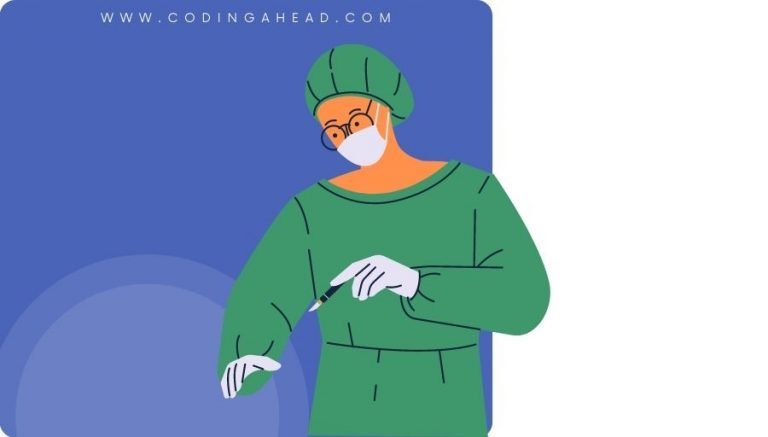How To Use CPT Code 29874
CPT 29874 involves the arthroscopic removal of loose or foreign bodies from the knee joint. This article will cover the description, procedure, qualifying circumstances, usage, documentation requirements, billing guidelines, historical information, similar codes, and examples of CPT 29874.
1. What is CPT 29874?
CPT 29874 is a medical procedure code used to describe the arthroscopic removal of loose or foreign bodies from the knee joint. This procedure is performed to alleviate pain, inflammation, scar tissue formation, adhesions, and restriction of motion caused by these loose or foreign bodies.
2. 29874 CPT code description
The official description of CPT code 29874 is: “Arthroscopy, knee, surgical; for removal of loose body or foreign body (eg, osteochondritis dissecans fragmentation, chondral fragmentation)”.
3. Procedure
- The patient is appropriately prepped and anesthetized.
- Small incisions are made in the knee area.
- The arthroscope is inserted through one of the incisions into the knee joint.
- Saline solution is instilled into the area to inflate the area around the knee joint.
- The provider inspects the joint and uses instruments to secure and remove any loose or foreign bodies.
- The area is irrigated and checked for bleeding.
- Any instruments are removed, and the incisions are closed.
4. Qualifying circumstances
Patients eligible to receive CPT code 29874 services are those experiencing pain, inflammation, scar tissue formation, adhesions, or restriction of motion in the knee joint due to the presence of loose or foreign bodies. These loose or foreign bodies may include small pieces of broken cartilage or other debris within the joint. The procedure is typically performed when conservative treatments, such as physical therapy or medication, have not provided sufficient relief.
5. When to use CPT code 29874
It is appropriate to bill the 29874 CPT code when the provider performs an arthroscopic removal of loose or foreign bodies from the knee joint to alleviate the patient’s symptoms and improve joint function. This code should be used only for surgical arthroscopy procedures and not for diagnostic arthroscopy.
6. Documentation requirements
To support a claim for CPT 29874, the following information should be documented:
- Patient’s medical history and symptoms related to the knee joint
- Physical examination findings, including any limitations in range of motion or joint instability
- Diagnostic imaging results, such as X-rays or MRI, showing the presence of loose or foreign bodies in the knee joint
- Conservative treatments attempted and their outcomes
- Details of the surgical procedure, including the location and size of incisions, instruments used, and the number and type of loose or foreign bodies removed
- Postoperative care instructions and follow-up plan
7. Billing guidelines
When billing for CPT code 29874, it is essential to follow the appropriate guidelines and rules. Surgical endoscopy and arthroscopy always include a diagnostic endoscopy or arthroscopy code, so a diagnostic code should never be used with a surgical code. If the provider performs a diagnostic arthroscopy and discovers the need for an open repair of a previously unknown condition, both the open repair and the diagnostic arthroscopy can be reported by appending the 59 modifier, Distinct procedural service, to the diagnostic arthroscopy code.
8. Historical information
CPT 29874 was added to the Current Procedural Terminology system on January 1, 1990. There have been no updates to the code since its addition.
9. Similar codes to CPT 29874
Five similar codes to CPT 29874 and how they differentiate from CPT 29874 are:
- CPT 29875: This code is used for arthroscopic debridement of the knee joint, which involves the removal of damaged tissue rather than loose or foreign bodies.
- CPT 29876: This code describes arthroscopic synovectomy, which involves the removal of inflamed synovial tissue from the knee joint.
- CPT 29877: This code is used for arthroscopic abrasion arthroplasty, which involves smoothing rough joint surfaces to reduce pain and improve function.
- CPT 29880: This code describes arthroscopic meniscectomy, which involves the removal of damaged meniscal tissue from the knee joint.
- CPT 29881: This code is used for arthroscopic meniscal repair, which involves the repair of torn meniscal tissue rather than removal.
10. Examples
Here are 10 detailed examples of CPT code 29874 procedures:
- A patient with a history of knee pain and swelling undergoes arthroscopic removal of a loose cartilage fragment from the knee joint.
- A patient with a history of knee trauma has an arthroscopic procedure to remove a foreign body, such as a small piece of glass, from the knee joint.
- A patient with osteochondritis dissecans undergoes arthroscopic removal of a loose osteochondral fragment from the knee joint.
- A patient with a history of knee pain and limited range of motion undergoes arthroscopic removal of multiple loose bodies from the knee joint.
- A patient with a history of knee pain and joint locking undergoes arthroscopic removal of a loose chondral fragment from the knee joint.
- A patient with a history of knee pain and joint instability undergoes arthroscopic removal of a loose meniscal fragment from the knee joint.
- A patient with a history of knee pain and joint clicking undergoes arthroscopic removal of a loose synovial fragment from the knee joint.
- A patient with a history of knee pain and joint stiffness undergoes arthroscopic removal of a loose ligament fragment from the knee joint.
- A patient with a history of knee pain and joint swelling undergoes arthroscopic removal of a loose bony fragment from the knee joint.
- A patient with a history of knee pain and joint crepitus undergoes arthroscopic removal of a loose tendon fragment from the knee joint.


